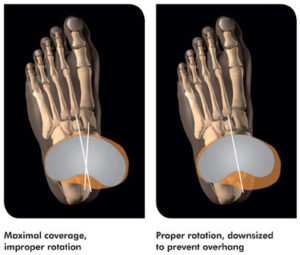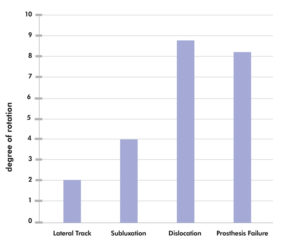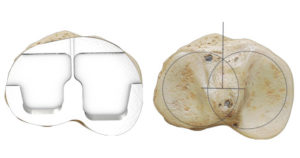No more compromises on tibial fit & rotation
Studies have shown that 10-15% of TKA patients have clinically significant residual pain,1,2 making it one of the principle drivers of patient dissatisfaction in knee replacement. One of the main culprits of residual pain can be found on the tibia. A study of painful knees after TKA found that 44% had significant rotational errors of the tibial tray.3 Mal-alignment of the tibial component – often a compromise resulting from poor implant fit – is a chief cause of pain following surgery. Patients with combined internal rotation were 5 times as likely to experience anterior knee pain, as shown in one study.4Traditionally, tibial component designs have come in a fixed range of sizes and dimensions. While the range of component sizes continues to grow, there often still remains a compromise between achieving optimal fit and proper rotational alignment.
Mal-alignment of the tibial component – often a compromise resulting from poor implant fit – is a chief cause of pain following surgery. Patients with combined internal rotation were 5 times as likely to experience anterior knee pain, as shown in one study.4Traditionally, tibial component designs have come in a fixed range of sizes and dimensions. While the range of component sizes continues to grow, there often still remains a compromise between achieving optimal fit and proper rotational alignment.
Typically component placement is optimized for coverage and as a result the majority of components are not set to proper rotation. One study examined both symmetric and asymmetric components and found that, when optimized for coverage, 70% were internally malrotated, at an average of 9°.5
Additionally, there is a direct correlation between combined internal rotation with the severity of patellofemoral complications. 6
Optimal Fit and Rotation – you can have both
By designing each tibial component to fit the size and shape of the patient’s resected tibia, Conformis is able to eliminate any compromise between correct sizing and proper rotational alignment (Figure 3). The tibial implant profile is matched to the cortical rim of the resection surface with slight relief to allow ±5° of intra-operative adjustment without overhang.
 A recent cohort studyof 33 patients intra-operatively compared tibial fit of Conformis iTotal® implants7 with off-the-shelf (OTS) TKAs in the same patient. While maintaining proper roational alignment, 0% of Conformis implants had ≥3mm of overhang compared with 21% for OTS implants. Additionally, only 12% of Conformis implants had underhang of >3mm compared with 30-39% for OTS implants.
A recent cohort studyof 33 patients intra-operatively compared tibial fit of Conformis iTotal® implants7 with off-the-shelf (OTS) TKAs in the same patient. While maintaining proper roational alignment, 0% of Conformis implants had ≥3mm of overhang compared with 21% for OTS implants. Additionally, only 12% of Conformis implants had underhang of >3mm compared with 30-39% for OTS implants.
By providing both optimal fit and proper rotation, customized implants help avoid the compromises that may contribute to patients’ post-operative pain and functional limitations.
1: Brander VA et al. Predicting total knee replacement pain: A prospective, observational study. ClinOrthopRelat Res. 2003;416:27-36.
2: Katz JN et al. Association Between Severe Pain in the Early Months Following Total Knee Replacement and Functional Outcomes Over Five-Year Follow-Up.World Congress of OA. Abstract 80.
3: Nicoll, et al; Internal Rotational Error of the Tibial Component is a Major Cause of Pain after Total Knee Replacement. The Journal of Bone and Joint Surgery; 2010, 92: 1238-1244
4: Barrack RL, et al; Component rotation and anterior knee pain after total knee arthroplasty. Clinic Orthop and Relat Res. 2001
5: Martin, et al; Maximizing Tibial Coverage Is Detrimental to Proper Rotational Alignment. Clinical Orthopaedics and Related Research; 2014, 472: 121-125
6: Berger RA, et al; Malrotation causing patellofemoral complications after total knee arthroplasty.Clinic Orthop and Relat Res. 1998.
7: Martin, Gregory; In-Vivo Tibial Fit Analysis of Customized, Patient-Specific TKA Versus Off-the-Shelf TKA. BASK Annual Meeting 2014.

